Imagine cold fingers creeping up someone’s calf. Now imagine that whenever you saw someone else being touched, you would feel the sensation on your own body. That is mirror-touch synesthesia.
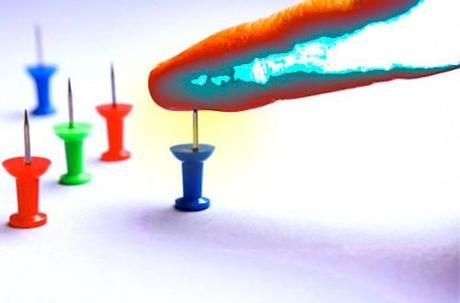
Psychologists at UCL verified mirror-touch synesthesia and further showed its linked with heightened empathy in their report in Nature Neuroscience.
Synesthesia–literally “joined sensation”–is a phenomena that involves one sense being detected through a different sense, or ideas concepts triggering automatic sensory experiences. Mirror touch synesthetes observing someone touched the left side of their cheek, perceive it as a touch on their own left cheek (anatomical), or on their right cheek (mirrored).
Mirror synesthesia was verified in subjects through a sensory interference task. Subjects were touched on either the left, right, both, or neither cheek(s), while observing someone else simultaneously being touched in either the same or different locations. When the observer was being touched in incongruent manners, synestheses made higher rates of errors than controls. Also subjects responded slower on incongruent trials than congruent trials (which I don’t think would be expected if subjects were faking there responses).
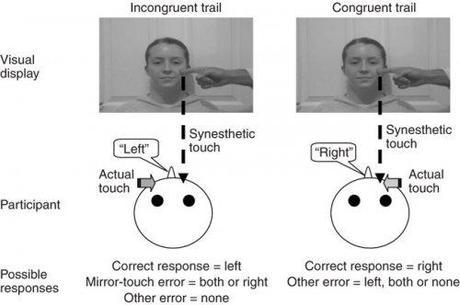
Banissy (2007) Nature Neuroscience
Then, the scientists measured empathy quotient (EQ) in mirror-touch synesthetes (n = 10), nonsynesthetic control participants (n = 20) and grapheme-color synesthetic controls (n = 25). While nonsynesthetic controls, and grapheme-color synesthetic controls were not significantly different, mirror-touch synesthetes showed significantly higher scores on the emotional reactivity subscale and trended higher in the other two subscales.
Can we explain the mechanism for these differences in perception and empathy between mirror-touch synesthetes and the rest of us? As the authors of the study point out, electrophysiological studies in monkeys show mirror neurons that activate with sensation and with the perceptions of those same sensations in others. Similarly, fMRI studies of humans watching someone else experience a sensation or an emotion, show increased activity in brain regions associated with the equivalent sensation or emotion. An fMRI showed mirror-touch synesthetes experience hyperactivity in this mirror-touch network, which might also explain their stronger reactions to others emotions. On the other side of the spectrum may be autistic individuals with deficits in imitation and empathy. So like with autism, could genes predispose someone to be a mirror-synesthete?
Genetics of Synesthesia
Back in November the Eagleman group of Baylor College of Medicine, published a genetic linkage study (full text) of colored-sequence synaesthesia (CSS) where letters, numbers, weekdays, or months that trigger colour experience. Neuroimaging studies show increased activation of V4 (which processes color sensation) in these synesthetes, as shown in the figure below.
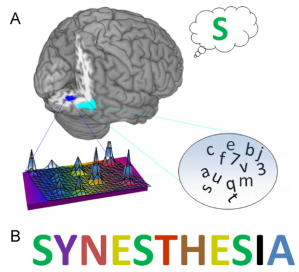
(A) In this model of synesthesia, neural populations coding for graphemes (right inferior temporal gyrus, light blue) ramify on those coding for colors (area V4, dark blue). As a result of these connections, activity triggered by a grapheme kindles V4 activity, and (B) synesthetes experience an automatic color association, an example of which is shown here. Tomson (2011) Brain Behavior and Research.
Its thought that this cross-talk between grapheme-processing and color processing areas exists because either:
- Excessive connections made early in development are insufficiently pruned
- There is an impairment to inhibitory systems that normally prevent cross-talk between the areas.
Grapheme-color synesthesia is one of the most common of the 150 reported forms of synaesthesia and runs in families. It can be verified through batteries that test the consistency of color associations over time, or through a kind of reverse-colorblindness test where patterns jump out at synesthetes much faster than for the rest of us.
For example, what patterns do you see here?
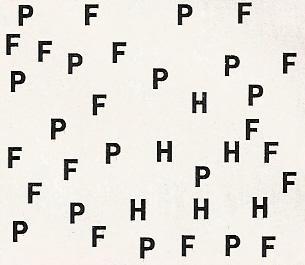
How about now?
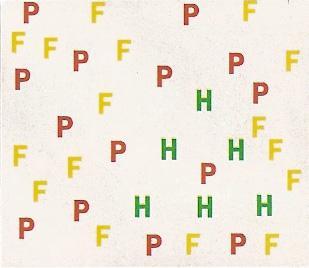
Five families with four or more individuals with color sequence synesthesia were recruited into the genetic linkage study. The Eagleman group tested for synesthesia in all available members of the family and generated the following pedigrees:
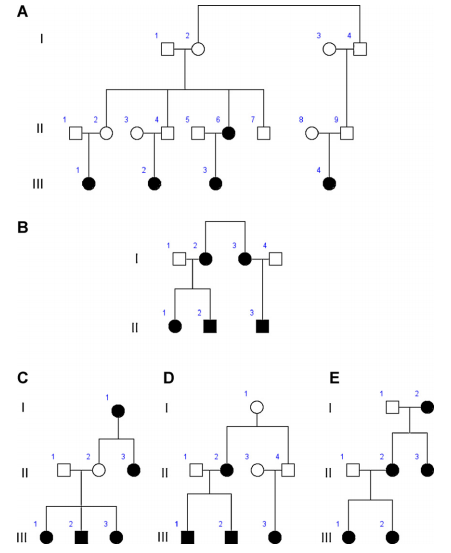
In families A and E it was only observed in females, in the other families it was observed with roughly equal probabilities in both males and females. Rectangles designate males, circles designate females, and black designates a verified color sequence synesthete. Tomson (2010) Behavioural Brain Research.
24 synesthetes and 24 controls were then genotyped using a PicoGreen SNP (Single Nucleotide Polymorphism) Array for 6090 SNPs to see if any locations of DNA seemed associated with the synesthesia. A 23 Megabase region on the long arm of chromosome 16 (q12.2-q23.1) was identified in families A & B, but not C, D, or E. Indicating that mutations in this region may be one cause or predisposition for grapheme-color synesthesia, but that there may be other causes. The region contains 343 genes, so it’s hard to determine exactly which ones might be involved, but the Eagleman group proposed 6 candidates: GABARAPL2, NDRG4, PLLP, KATNB1, and CIAPIN1. These genes were sequenced in four synesthetes however none of the polymorphisms observed were duplicates and none were novel. More in depth sequencing will be required to determine the precise genes involved. Larger haplotyping studies could also uncover the regions involved in families C, D, & E.
Identifying the genes associated with grapheme-color synesthesia could answer a bigger question. Are all these disorders we call synesthesias biologically or mechanistically related to each other, or is it a diverse group of phenomena we have lumped together because of similarities in their phenotype? The discovery could also help explain observations of synesthesia during hallucinogenic drug use, mediation, or the acquisition of synesthesia from sensory loss, or by choice in the case of a 10-year-old boy with Aspergers.

